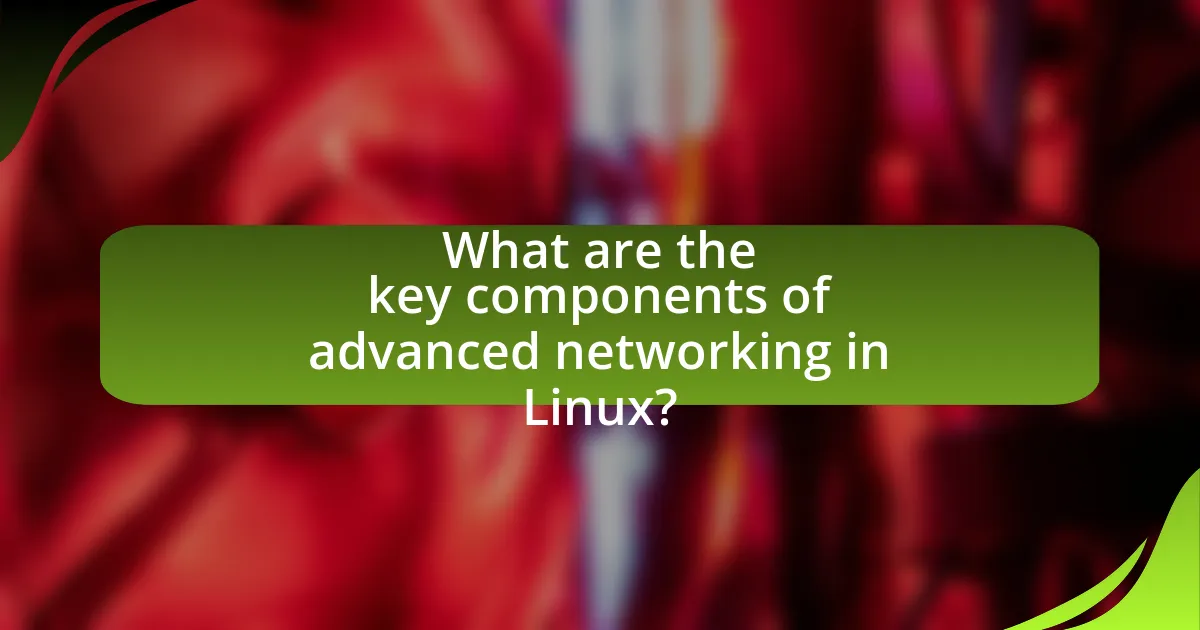Advanced networking techniques for Linux system administrators encompass a range of strategies and tools designed to optimize network performance, enhance security, and facilitate efficient resource management. Key components include network namespaces, bridging, advanced routing protocols, and tools such as Wireshark and Nmap, which aid in monitoring and analyzing network traffic. These techniques not only improve data transmission efficiency and reduce latency but also bolster security through robust access controls and network segmentation. The article further explores practical applications of these techniques in cloud environments, best practices for implementation, and common troubleshooting strategies to address networking issues faced by administrators.

What are Advanced Networking Techniques for Linux System Administrators?
Advanced networking techniques for Linux system administrators include the use of network namespaces, bridging, and advanced routing protocols. Network namespaces allow administrators to create isolated network environments, enabling multiple applications to run on the same host without interfering with each other. Bridging techniques facilitate the connection of different network segments, allowing seamless communication between them. Advanced routing protocols, such as BGP (Border Gateway Protocol) and OSPF (Open Shortest Path First), enhance the efficiency and reliability of data transmission across complex networks. These techniques are essential for optimizing network performance and ensuring robust security in Linux environments.
How do these techniques enhance network performance?
Advanced networking techniques enhance network performance by optimizing data transmission, reducing latency, and improving bandwidth utilization. Techniques such as Quality of Service (QoS) prioritize critical traffic, ensuring that essential applications receive the necessary bandwidth, which leads to smoother performance. Additionally, the implementation of network protocols like Multiprotocol Label Switching (MPLS) allows for faster data routing and reduced congestion, further enhancing overall network efficiency. Studies have shown that organizations employing these techniques can experience up to a 30% increase in throughput and a significant reduction in packet loss, validating their effectiveness in improving network performance.
What specific tools are used in advanced networking?
Specific tools used in advanced networking include Wireshark, tcpdump, and Nmap. Wireshark is a network protocol analyzer that allows users to capture and interactively browse traffic on a computer network. Tcpdump is a command-line packet analyzer that enables users to display TCP, UDP, and other packets transmitted or received over a network. Nmap is a network scanning tool that is used for network discovery and security auditing. These tools are widely recognized in the field for their effectiveness in monitoring, analyzing, and securing network traffic.
How do these tools interact with Linux systems?
These tools interact with Linux systems by utilizing system calls and APIs to perform network-related tasks. For instance, tools like Wireshark capture and analyze network packets by leveraging the libpcap library, which interfaces directly with the Linux kernel to access network traffic. Additionally, command-line utilities such as netstat and ifconfig interact with the Linux networking stack to provide real-time information about network connections and interface configurations. This interaction is facilitated through the use of sockets and network protocols defined in the Linux kernel, ensuring efficient communication and data handling.
Why are advanced networking techniques essential for Linux system administration?
Advanced networking techniques are essential for Linux system administration because they enable efficient management, troubleshooting, and optimization of network resources. These techniques, such as VLAN configuration, network monitoring, and firewall management, allow system administrators to ensure secure and reliable communication between systems. For instance, the implementation of advanced routing protocols can significantly enhance network performance and reduce latency, which is critical for maintaining service availability. Furthermore, knowledge of advanced networking tools, like Wireshark and iptables, empowers administrators to diagnose and resolve network issues swiftly, minimizing downtime and improving overall system reliability.
What challenges do system administrators face without these techniques?
System administrators face significant challenges without advanced networking techniques, including increased downtime, inefficient resource management, and heightened security vulnerabilities. Without these techniques, administrators struggle to optimize network performance, leading to slower response times and potential service interruptions. Additionally, the lack of advanced monitoring and troubleshooting tools can result in prolonged outages, as issues may go undetected until they escalate. Security risks also rise, as outdated methods may not adequately protect against modern threats, leaving systems exposed to attacks. These challenges underscore the necessity of employing advanced networking techniques to ensure reliable, efficient, and secure system administration.
How do these techniques improve security in Linux environments?
Advanced networking techniques improve security in Linux environments by implementing robust access controls, enhancing data encryption, and facilitating network segmentation. These techniques, such as the use of firewalls, VPNs, and intrusion detection systems, create multiple layers of defense against unauthorized access and data breaches. For instance, employing a firewall can restrict incoming and outgoing traffic based on predetermined security rules, effectively minimizing exposure to potential threats. Additionally, utilizing VPNs encrypts data in transit, safeguarding sensitive information from interception. Network segmentation further limits the spread of attacks by isolating different segments of the network, thereby containing potential breaches. These methods collectively strengthen the overall security posture of Linux systems, making them more resilient against cyber threats.

What are the key components of advanced networking in Linux?
The key components of advanced networking in Linux include network namespaces, virtual network interfaces, bridging, routing, and firewall management. Network namespaces allow the creation of isolated network environments, enabling multiple network stacks on a single host. Virtual network interfaces, such as tap and tun devices, facilitate the creation of virtual networks for applications. Bridging connects multiple network segments, allowing them to function as a single network. Routing enables the forwarding of packets between different networks, while firewall management, often implemented through iptables or nftables, controls traffic flow and enhances security. These components collectively enhance the flexibility, scalability, and security of networking in Linux environments.
How do routing and switching work in Linux networking?
Routing and switching in Linux networking involve directing data packets between devices and managing traffic within a network. Linux uses the kernel’s networking stack, which includes routing tables and network interfaces, to determine the best path for data transmission. The routing process relies on protocols like IP (Internet Protocol) to forward packets based on destination addresses, while switching occurs at the data link layer, utilizing MAC (Media Access Control) addresses to facilitate communication within the same local network segment. The Linux command-line tools, such as ip route for routing and brctl for bridging, enable administrators to configure and manage these functions effectively.
What are the differences between static and dynamic routing?
Static routing involves manually configuring routes in a network, while dynamic routing automatically adjusts routes based on current network conditions. Static routing is typically used in smaller networks where routes do not change frequently, providing simplicity and predictability. In contrast, dynamic routing protocols, such as OSPF and BGP, enable routers to communicate and share information about network topology changes, allowing for more efficient routing in larger, more complex networks. The key difference lies in the management: static routing requires manual updates, whereas dynamic routing adapts automatically, enhancing resilience and scalability.
How can Linux handle VLANs effectively?
Linux can handle VLANs effectively by utilizing the 802.1Q standard for VLAN tagging, which allows multiple virtual networks to coexist on a single physical interface. This capability is implemented through the use of network namespaces and virtual interfaces, enabling system administrators to create, manage, and isolate VLANs efficiently. The Linux kernel supports VLANs natively, allowing for easy configuration using tools like ip command or vconfig, which facilitate the addition and removal of VLAN interfaces. Additionally, Linux’s robust networking stack ensures high performance and scalability, making it suitable for environments with extensive network segmentation requirements.
What role does network monitoring play in advanced networking?
Network monitoring is essential in advanced networking as it enables real-time visibility into network performance, security, and reliability. By continuously analyzing traffic patterns and system health, network monitoring tools help identify bottlenecks, detect anomalies, and ensure optimal resource utilization. For instance, according to a report by Gartner, organizations that implement effective network monitoring can reduce downtime by up to 50%, demonstrating its critical role in maintaining network efficiency and security.
Which tools are best for monitoring Linux networks?
The best tools for monitoring Linux networks include Nagios, Zabbix, and Prometheus. Nagios provides comprehensive monitoring capabilities for network services, host resources, and server performance, making it a widely used solution in enterprise environments. Zabbix offers real-time monitoring and visualization of network performance, with features like alerting and reporting, which are essential for proactive network management. Prometheus, known for its powerful querying language and time-series data storage, excels in monitoring dynamic cloud environments and microservices. These tools are validated by their extensive use in production environments and their ability to integrate with various systems, ensuring effective network oversight.
How can monitoring improve network reliability?
Monitoring can improve network reliability by providing real-time visibility into network performance and identifying issues before they escalate. By continuously tracking metrics such as bandwidth usage, latency, and packet loss, network administrators can quickly detect anomalies and address potential problems. For instance, a study by the International Journal of Computer Applications found that proactive monitoring reduced downtime by up to 50%, demonstrating its effectiveness in maintaining network stability.

What are some practical applications of advanced networking techniques?
Advanced networking techniques have several practical applications, including network optimization, enhanced security, and improved data management. For instance, techniques such as Quality of Service (QoS) enable prioritization of critical network traffic, ensuring that essential applications receive the necessary bandwidth, which is crucial for maintaining performance in environments with high data demands. Additionally, advanced networking techniques like Virtual Private Networks (VPNs) and firewalls enhance security by encrypting data and controlling access to sensitive information, thereby protecting against unauthorized access and cyber threats. Furthermore, software-defined networking (SDN) allows for dynamic management of network resources, facilitating efficient data flow and reducing latency, which is particularly beneficial in cloud computing environments. These applications demonstrate the effectiveness of advanced networking techniques in optimizing performance, securing data, and managing resources efficiently.
How can advanced networking techniques be applied in cloud environments?
Advanced networking techniques can be applied in cloud environments through the implementation of software-defined networking (SDN) and network function virtualization (NFV). SDN allows for centralized control of network resources, enabling dynamic management of traffic flows and improved scalability, which is essential in cloud infrastructures that require flexibility and rapid provisioning. NFV complements this by virtualizing network services, such as firewalls and load balancers, allowing them to run on standard hardware rather than dedicated appliances, thus reducing costs and increasing deployment speed. These techniques enhance network performance, security, and resource utilization in cloud environments, as evidenced by studies showing that organizations adopting SDN and NFV can achieve up to 50% reduction in operational costs and improved service delivery times.
What are the benefits of using Linux for cloud networking?
Linux offers several benefits for cloud networking, including cost-effectiveness, flexibility, and strong community support. Its open-source nature allows organizations to customize their networking solutions without incurring licensing fees, making it a budget-friendly option. Additionally, Linux supports a wide range of networking tools and protocols, enabling seamless integration with various cloud services. The extensive community contributes to rapid updates and security patches, ensuring that Linux remains a reliable choice for cloud networking environments. Furthermore, many cloud providers, such as AWS and Google Cloud, offer native support for Linux distributions, enhancing compatibility and performance in cloud deployments.
How do advanced techniques facilitate hybrid cloud solutions?
Advanced techniques facilitate hybrid cloud solutions by enabling seamless integration and management of resources across on-premises and cloud environments. These techniques, such as software-defined networking (SDN) and network function virtualization (NFV), allow for dynamic resource allocation, improved security, and enhanced performance. For instance, SDN provides centralized control over network traffic, enabling administrators to optimize data flow and reduce latency, which is crucial for hybrid cloud operations. Additionally, NFV allows for the deployment of network services without the need for dedicated hardware, thus increasing flexibility and scalability. These advancements ensure that organizations can efficiently leverage both private and public cloud resources, ultimately leading to improved operational efficiency and cost-effectiveness.
What are best practices for implementing advanced networking techniques?
Best practices for implementing advanced networking techniques include thorough planning, proper configuration, and continuous monitoring. Planning involves assessing network requirements and designing a scalable architecture that accommodates future growth. Proper configuration ensures that devices are set up correctly, utilizing protocols like VLANs for segmentation and QoS for prioritizing traffic. Continuous monitoring with tools such as Nagios or Zabbix allows administrators to detect issues proactively and optimize performance. These practices are supported by industry standards, such as the Cisco Networking Academy’s guidelines, which emphasize the importance of structured approaches to network management.
How can system administrators ensure network security during implementation?
System administrators can ensure network security during implementation by employing a multi-layered security approach that includes firewalls, intrusion detection systems, and secure configurations. Implementing firewalls helps to filter incoming and outgoing traffic based on predetermined security rules, thereby preventing unauthorized access. Intrusion detection systems monitor network traffic for suspicious activities and alert administrators to potential threats. Additionally, secure configurations of network devices and services reduce vulnerabilities by disabling unnecessary features and applying the principle of least privilege. According to a study by the National Institute of Standards and Technology (NIST), organizations that adopt a layered security strategy significantly reduce their risk of data breaches.
What common pitfalls should be avoided in advanced networking?
Common pitfalls to avoid in advanced networking include neglecting proper documentation, failing to implement security measures, and overlooking network performance monitoring. Proper documentation is essential for troubleshooting and maintaining network configurations; without it, administrators may struggle to identify issues or replicate setups. Implementing security measures, such as firewalls and encryption, is crucial to protect sensitive data and prevent unauthorized access; neglecting these can lead to significant vulnerabilities. Additionally, overlooking network performance monitoring can result in undetected bottlenecks or failures, which can severely impact service availability and user experience. These pitfalls can lead to increased downtime, security breaches, and inefficient network operations.
What troubleshooting strategies can be employed for advanced networking issues?
Advanced networking issues can be effectively addressed using several troubleshooting strategies, including systematic isolation of the problem, utilizing network monitoring tools, and analyzing logs. Systematic isolation involves breaking down the network into smaller segments to identify where the issue lies, which can help pinpoint the source of the problem. Network monitoring tools, such as Wireshark or tcpdump, allow administrators to capture and analyze traffic, providing insights into anomalies or bottlenecks. Additionally, analyzing logs from routers, switches, and servers can reveal error messages or unusual patterns that indicate underlying issues. These strategies are validated by their widespread use in the industry, demonstrating their effectiveness in diagnosing and resolving complex networking problems.
How can logs and monitoring data assist in troubleshooting?
Logs and monitoring data assist in troubleshooting by providing detailed records of system events and performance metrics, which help identify the root cause of issues. For instance, logs capture error messages, system alerts, and user activities, allowing administrators to trace back the sequence of events leading to a problem. Monitoring data, such as CPU usage, memory consumption, and network traffic, offers insights into system performance and can highlight anomalies that may indicate underlying issues. Together, these tools enable Linux system administrators to quickly diagnose problems, reduce downtime, and implement effective solutions based on concrete evidence from the system’s operational history.
What are the most common networking issues faced by Linux administrators?
The most common networking issues faced by Linux administrators include misconfigured network interfaces, DNS resolution problems, firewall misconfigurations, and issues with network services such as DHCP and NTP. Misconfigured network interfaces can lead to connectivity problems, as incorrect IP addresses or subnet masks prevent proper communication. DNS resolution problems often arise from incorrect DNS server settings or issues with the DNS service itself, causing failures in hostname resolution. Firewall misconfigurations can block necessary traffic, leading to service disruptions. Additionally, issues with network services like DHCP can prevent devices from obtaining IP addresses, while NTP issues can lead to time synchronization problems, affecting various applications and services. These issues are frequently encountered in Linux environments, highlighting the importance of proper configuration and monitoring.



